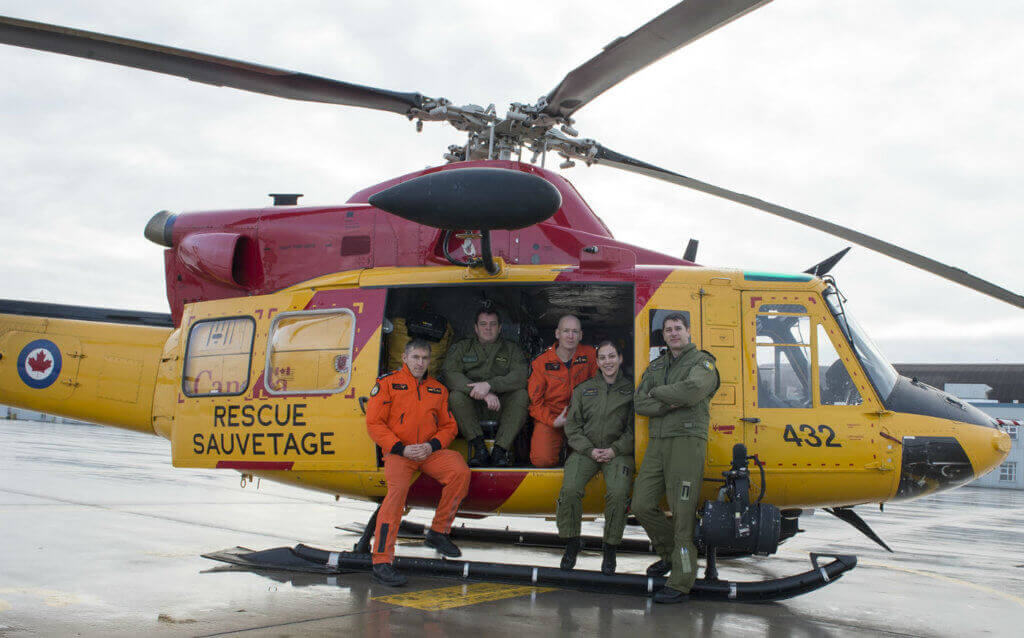The beautiful Great Lakes are perfect for boating during warm summer days. If you visit them often enough, chances are you may have spotted a CH-146 Griffon helicopter flying above them at some point. Have you ever looked up and wondered what they are there for?

Capt Nicolas Bossé is a search-and-rescue (SAR) Griffon helicopter pilot dedicated to saving lives. Thanks to him and many other SAR personnel, Canadian Armed Forces SAR units respond to about 400 calls every year in Central Canada.
One of these calls came on June 19, 2016, when a male jet skier was reported overdue in Inner Bay in Norfolk County, Ontario, on Lake Erie. Bossé was the aircraft commander tasked to lead his team from 424 Transport and Rescue Squadron, 8 Wing Trenton, to locate the jet skier. His team included two pilots, two SAR technicians, and a flight engineer. The mission was led by the Canadian Coast Guard and supported by the Norfolk Fire Department and the Canadian Armed Forces.
Bossé and his team made the necessary plans before flying out, including gathering information about the jet skier.
“Usually when we get a call similar to this, we want to know the sex and age of the person,” explains Bossé. “We ask for any medical conditions that the person may have — for example, cardiac conditions or diabetes — so before going out we know a little about the person we are looking for and can anticipate the type of treatment the SAR techs may have to administer. We also ask for the person’s last known location, the possible route he might have taken and whether he was familiar with the area.”
Since it was a windy and dark night, and the search was going to take place over the water, Bossé requested the support of the CC-130 Hercules. During night SAR missions, the Hercules flies higher than the Griffon and, at the request of the Griffon aircraft commander, it can use flares to illuminate the sky. This increases the chance of finding the missing person.
The Hercules team can also search for signs of distress. If a sign of distress is found, the Hercules team notifies the Griffon team, which flies closer to the water and investigates further.
The winds were so harsh that Bossé and his team had to stop for fuel along the way, despite leaving Trenton with a full tank. In the meantime, the Hercules crew made it to the location and started searching for the missing person.
About 10 to 15 minutes after arriving and beginning the search, the Canadian Coast Guard team on the water notified Bossé and his team that the local fire department on land had heard some shouting.
“We asked for their position and we made our way towards that location,” he said. “We started searching an area covered with five- to six-foot tall grass with several narrow paths in the grass. After looking around for some time, we spotted somebody on the water. We investigated a bit more and we found the overdue person standing on his jet ski frantically waving.”
Earlier that day, the jet skier took one of the paths in the tall grass as a short cut to get back home. After getting lost in the tall grass and trying to find a new way home, his jet ski ran out of fuel.
When the Griffon team located the man, Bossé took over as the pilot and flew the aircraft while a SAR technician was lowered into the water. Bossé and his team then hoisted the jet skier onboard the Griffon.
While the man was in good shape, it was approximately 1 a.m. when he was rescued and he was visibly tired, according to Bossé. The SAR team flew the man to the nearest hospital and concluded their successful mission.
Not every mission comes without its challenges, though. “For us, the most challenging thing while flying the Griffon helicopter is having to do a hoist sequence over the water with few hover references,” said Bossé. “That’s why when we do this type of mission over water we always ask for Hercules support so they can provide illumination, which helps us a lot in maintaining a steadier hover.”
This particular mission lasted approximately five hours from the moment the SAR team was tasked to the moment the jet skier was brought to the hospital.
Bossé says that getting enough rest is crucial to helping him perform well at his job, because it’s impossible to know how long a mission will last. “As soon as we get a call, we’re supposed to be able to provide a 15-crew day,” he explains. “That means we could be tasked to work a 15-hour tasking.”
Even though the job comes with its challenges and long hours, Bossé says the feeling of saving a life is worth it.
“When we brought this person on board the chopper, I turned around and saw him smiling and I could see a sign of relief on his face: ‘I’m on board now, I’m safe’. It was really, really rewarding,” he says. “For this mission and any mission where we save lives, it is extremely rewarding because we make a difference.”









